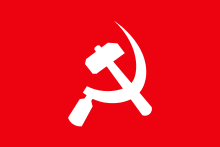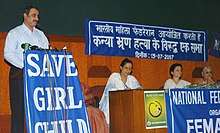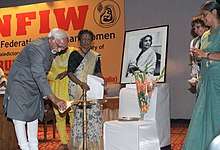National Federation of Indian Women
National Federation of Indian Women is a women's organisation. It was established in 1954 June 4th by several leaders from Mahila Atma Raksha Samiti including Aruna Asaf Ali.[1][2]
| Part of a series on |
| Communism in India |
|---|
 |
|
Personalities
|
|
Cold War years
|
|
Other articles |
|
|
.jpg)
Annie Raja is the current General Secretary and Aruna Roy is the current president of NFIW
History



The first Congress of the NFIW (Calcutta, June 4 1954) was held against the backdrop of the Cold War and military pacts, lending a certain poignancy to its declaration of “unshakeable opposition to large scale armaments, weapons of mass destruction such as hydrogen bomb, atom bomb and bacteriological weapons.”
Inspired by a vision of women across the globe uniting against imperialism, poverty and disease, leading figures such as Vidya Munsi, Ela Reid, Hajrah Begum, Anna Mascarene, Renu Chakravartty, Tara Reddy, Shanta Deb and Anasuya Gyanchand participated in meetings of the Women's International Democratic Federation (WIDF), World Conference of Mothers (Lausanne, 1955), Afro-Asian Women's Conference (Cairo, 1961), the anniversary of the victory of Vietnam (Ho Chi Minh city, 1977), and so on.
From Vijaywada in Andhra Pradesh, in 1957, NFIW President Pushpamayee Bose issued a rousing appeal: “We, the women of the Federation declare that we do not want war, neither here nor anywhere in the world… We demand from the Big Powers not only stoppage of all nuclear tests but cessation of all wars for the world good - we ask them not to waste their men, money and brains on war preparation but use it for the well-being of their countries”.
Many women's organisations joined NFIW, united by the common goal of securing women's rights. At the founding conference in 1954, 39 organisations had already joined in, yielding a membership of nearly 1.3 lakh women from peasants, workers, tribals, dalits and refugees to professionals, artists and intellectuals. Constituent organisations included Mahila Atma Raksha Samiti (MARS, West Bengal), Punjab Lok Istri Sabha, Nari Mangal Samiti (Orissa), and Manipur Mahila Samiti.
References
- Menon, Parvathi. Breaking Barriers: Stories of Twelve Women. New Delhi: LeftWord, 2005. p. 37
- Overstreet, Gene D., and Marshall Windmiller. Communism in India. Berkeley: University of California Press, 1959. p. 402